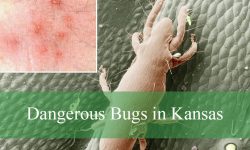All types of green caterpillars are recognizable in the garden. These green crawling creatures love munching the leaves of edible plants, ornamental shrubs and trees for nutrition and energy.
Figuring out the exact name for these green caterpillars can be a daunting experience for many gardeners. Here is a list of 50 types of green caterpillars with their description and pictures for easy identification.
Are Green Caterpillars Poisonous?
Green caterpillars are harmless and non-poisonous. But some species have stinging hairs or spikes that can cause skin irritation and nasty rashes upon handling them.
We recommend handling all species of green caterpillars with protective gloves to protect yourself from skin irritation or the foul smell. (Source: Ohio State University).
Some menacing looking green caterpillars can appear scary but they are harmless to humans or pets. Those with sharp spines or horns are for warding off predators.
Different Types of Green Caterpillars with Pictures
Green caterpillars are beautiful and friendly. These crawling insects resemble monarch butterflies and feed on different types of green leaves for nutrition and energy. Here is a comprehensive list of 50 kinds of green caterpillars with their descriptions and pictures:
Lacecapped Caterpillar
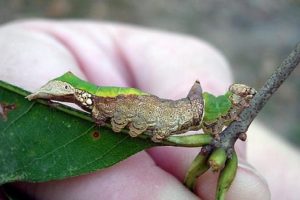
It is a large green moth caterpillar with conspicuous mottled gray patches on its back and sides. The larva can easily be confused with a bird poop due their similarities.
The color patterns make this caterpillar camouflage in its habitat and protect it from potential predators. It can grow up to 4.5cm long.
Lacecapped caterpillars feed on the leaves of beech, oak, and chestnut trees. They do not sting or cause skin irritation due to lack of hairs.
Scientific Name |
Oligocentria lignicolor |
Host Plants |
Beech, oak, and chestnut trees |
Identification Features |
Green body with prominent mottled gray patches on the back and sides. |
Georgian Prominent Caterpillar
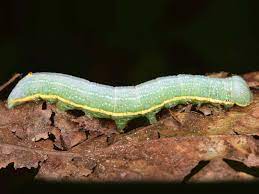
The moth caterpillar is large with pale-green body and continuous yellow band along its abdomen. The small faint green blotches on its back are the distinctive features.
Another identification feature is the orangish-red bump on its tail. These caterpillars feed on deciduous trees from North America.
Scientific Name |
Hyperaeschra georgica |
Host Plants |
Deciduous trees in North America |
Identification Features |
Whitish-green body with conspicuous yellow, red-edged striped along its sides. |
Bedstraw Hawk-Moth Caterpillar
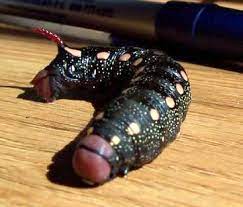
It is a green hornworm caterpillar with dark green abdomen and bright creamy-yellow spots band along its body. The caterpillar can grow up to 8cm long.
Other distinctive features for easy identification are arched red tail horn, bluish-green head, and black prolegs. They also have cigar-shaped body with yellow spots.
Scientific Name |
Hyles gallii |
Host Plants |
Fireweed, bedstraw, fuchsia, and plantago plants |
Identification Features |
Large green larva with cylindrical body shape and yellow spots band along its sides. |
Snowberry Clearwing Moth Caterpillar
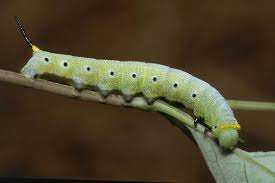
It is a pale lime-green larva with a conspicuous black tail spike. Other distinctive features are bluish-black dots on its sides with green and yellow longitudinal bands.
The tiny white granular spots on the green body are also ideal for easy recognition and identification. Mature snowberry caterpillars turn into brown before pupation.
Scientific Name |
Hemaris diffinis |
Host Plants |
Lantana, honeysuckle, thistles, Canada violet, and lilac plants. |
Identification Features |
Green larva with a yellow band behind the head, a black spike on its tail and black spots on its abdomen. |
Gray Furcula Moth Caterpillar
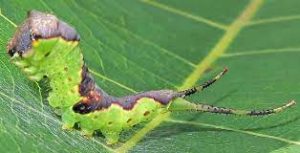
It is a moth caterpillar with a strange looking green body and large blackish-brown pattern on its back. The yellow margins on the patterns are the distinctive features.
The caterpillar also has an elongated pointed tail and flattened head for easy recognition. The sides have speckled brown and orange dots for easy identification.
Scientific Name |
Furcula cinerea |
Host Plants |
Betula, populus and salix species. |
Identification Features |
Green abdomen with large brownish-black patches with faint orange marks. |
Virginia Creeper Sphinx Moth Caterpillar

These moth caterpillars are often seen in Florida, Maine, and other eastern states in the United States. The horned green caterpillar can grow up to 5cm long.
Virginia creeper sphinx moth caterpillar has a large head with reddish-brown marks on its back and faint pale green speckles.
The bulging head and yellowish green streaks on its sides are the distinctive features for easy identification. They feed on Virginia creepers and grape leaves.
Scientific Name |
Darapsa Myron |
Host Plants |
Virginia creepers |
Identification Features |
Brownish dorsal markings with enlarged head and pointed tail |
Promethea Silkmoth Caterpillar
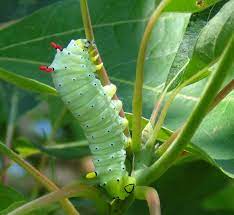
It is a blue-green fat caterpillar with four bright red protuberances on its head and a yellow tail. The bluish-black tubercles line on sides and back are the identification traits.
Other distinctive features are the pale-yellow forelegs and prolegs. These plump green caterpillars have voracious appetite and feeds on ornamental and deciduous trees.
Scientific Name |
Callosamia promethea |
Host Plants |
Black cherry, spice bush, and sassafras |
Identification Features |
Four bright red protuberances on the head, blue-green body, and yellow tail |
Box Tree Caterpillar
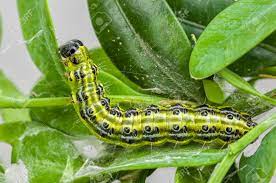
It is a green caterpillar with black and yellow bands running lengthwise. The round black head with white patterns, yellow, green, and black bands are the distinctive features.
The box tree caterpillar has fine white spines and black dots on its back for easy identification. It can grow up to 4cm long due to its voracious appetite.
Scientific Name |
Cydalima perspectalis |
Host Plants |
Boxwood shrubs |
Identification Features |
Green striped caterpillar with cylindrical body and black head. Black dots on the abdomen produce fine setae. |
Oleander Hawk Moth Caterpillar
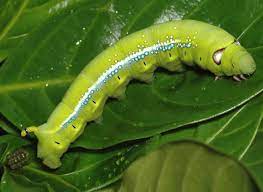
It is a large moth caterpillar with a green body, rear yellow fleshy horn, and two large blue and white eyespots. It can grow up to 8.5cm long.
The hawk moth caterpillar also has white and pale blue stripes on its sides for easy identification. It late develops dark charcoal color with orange patches at the ends.
Scientific Name |
Daphnis nerii |
Host Plants |
Oleander plants |
Identification Features |
Vibrant horned green caterpillar with a band of blue and white markings along its sides. |
Copper Underwing Moth Caterpillar
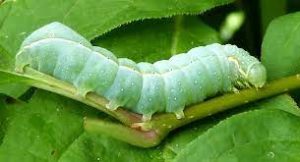
It is a green caterpillar with conspicuous yellow and white bands along its sides. The numerous blue dots and white trims are other identification features.
The green abdomen is covered with yellow dots and patterns. It can grow up to 4.5cm long due to its voracious appetite for leaves.
Other distinctive features are the humped tail part and rounded green head. These caterpillars are often seen in spring feeding on fruit trees and other deciduous trees.
Scientific Name |
Amphipyra pyramidoides |
Host Plants |
Ash, honeysuckle, apple, oak, lilac and rose |
Identification Features |
Plump green caterpillar with yellow dots and a white-yellow line running lengthwise. |
Silver-Spotted Skipper Caterpillar

It is a strange looking yellowish-green caterpillar with a reddish-brown head and thin traversing stripes along its abdomen.
The orange eyespots, three pairs of red forelegs, and eight orange prolegs are other identification features. You can also use the reddish-brown band behind its head.
Scientific Name |
Epargyreus clarus |
Host Plants |
Shrubs, vines, and herbs |
Identification Features |
Slug-like yellowish green caterpillar with thin traversing stripes, reddish brown head, and orange legs. |
Orange-Barred Sulphur Caterpillar
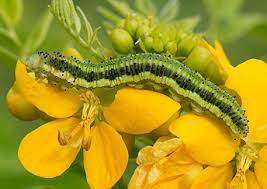
It is a pale yellow-green caterpillar with two longitudinal black bands running from the head to the tail. The small fleshy bumps are also some distinctive features.
These crawling insects feed on dark green leaves that determine their body color. They are also covered in stumpy fleshy black spines.
Scientific Name |
Phoebis philea |
Host Plants |
Pea family plants |
Identification Features |
Yellowish-green body with wide black bands running lengthwise. |
Northern Pearly-Eye Caterpillar
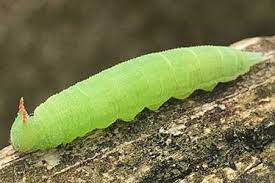
It is a pale green caterpillar with pinkish horns, row of brightly-colored yellow dots, and fine hairs. The pointed tail end and oval head are other identification features.
The yellowish-green caterpillar can grow up to 4.5cm long and feeds on different types of grasses. It turns into a spectacular brown butterfly after pupation.
Scientific Name |
Enodia anthedon |
Host Plants |
All types of grasses |
Identification Features |
Pale green caterpillar covered in tiny yellow speckles and fine hairs. |
Honey Locust Moth Caterpillar
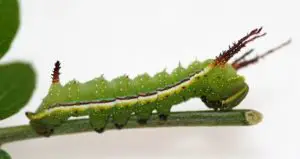
It is a green moth caterpillar with white speckled tubercles. Other identification features are a pair of fleshy reddish horns, white spiny hairs, white and red stripes on the sides.
The strange looking head has yellow bands on the face and the caterpillar can grow up to 3.5cm long. It feeds on the leaves of honey locust and Kentucky coffee trees.
Scientific Name |
Syssphinx bicolor |
Host Plants |
Honey locust trees and Kentucky coffee trees |
Identification Features |
Dark green abdomen with a pair of fleshy red horns at both ends and white speckles. |
Eumorpha Sphinx Caterpillar
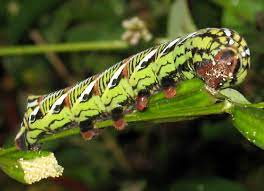
It is a unique green caterpillar with numerous color variations. The large moth larva has a row of black dots along its sides, spiked tail, and diagonal yellowish-white stripes.
Other distinctive features are yellowish-green body with red bands. The yellow and white stripes make it easy to identify the green caterpillar.
Scientific Name |
Eumorpha fasciatus |
Host Plants |
Evening primrose, magnolia, grapes, and fuchsia |
Identification Features |
Green body with shades of yellow, black, red, and orange or white colors |
Common Pine Sawfly
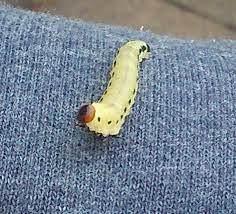
It is a pale green bug with a black line along its back and black spots band on its sides for easy identification. The small crawling bug can grow up to 1cm long.
The rounded orange head with black dots are prominent when the common pine sawfly larva is about to enter pupation phase.
Scientific Name |
Diprion pini |
Host Plants |
Scot pines |
Identification Features |
Caterpillar-like bug with pale green body and black bands running lengthwise. |
Polyphemus Moth Caterpillar
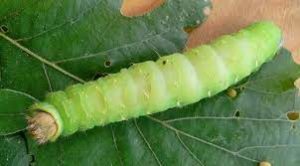
It is a lime-green moth caterpillar with bright red bumps where long setae emanate to give the crawling insect a slightly hairy appearance.
The moth caterpillar can grow up to 10cm long and keep changing its color in each growth phase. Juvenile species have black and white stripes along its abdomen.
Scientific Name |
Antheraea polyphemus |
Host Plants |
Apple, ash, birch, dogwood, elm, hazel, maple, rose, and willow. |
Identification Features |
Reddish bumps around the lime-green body. |
Forester Moth Caterpillar
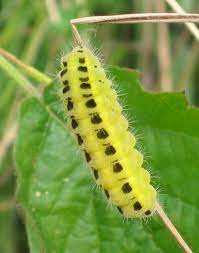
It is a yellowish-green slug-like caterpillar with two rows of black spots running on the black and spiky tufts of hair. It can grow up to 12.5cm long before pupation.
These caterpillars are native to warm subtropical climates of Southern United States due to the presence of herbaceous plants.
Scientific Name |
Zygaenidae |
Host Plants |
Herbaceous plants |
Identification Features |
Yellowish-green slug-like caterpillar with black dots and spiny tufts of hairs on its body. |
Long-Tailed Skipper Caterpillar
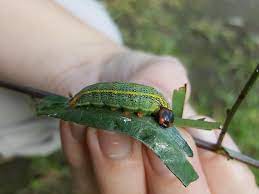
It is a large green caterpillar with a unique rounded brownish-black head and body covered in yellow dots. The cigar-shaped caterpillar has a voracious appetite.
Other identification features are thin yellow lines along the back, orange prolegs, and two-orange markings on its tail.
Scientific Name |
Urbanus proteus |
Host Plants |
Bean plants, beggar weeds, pea plants, and hog peanut plants. |
Identification Features |
Green body with yellow dot bands and lines running lengthwise. |
Imperial Moth Caterpillar
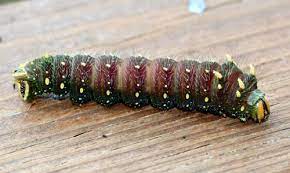
It is a fat green moth caterpillar with a row of yellow dots along the sides and yellow spiny horns on its ends. The moth larva is non-venomous but cause crop damages.
Some species have brown and burgundy colors with a body size of 10cm. They feed on the leaves of hickory, sweetgum, elm, oak, and maple trees.
Scientific Name |
Eacles imperialis |
Host Plants |
Hickory, sweetgum, elm, oak, maple, beech, cypresses, and red cedar |
Identification Features |
Fat green caterpillar with row of yellow dots along its sides and yellowish spiny horns on its ends. |
Cabbage Looper Caterpillars
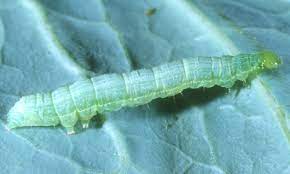
The crawling insect makes large arching actions when in motion. These worm-like creatures are slightly hairy due to the fine bristles.
These cabbage looper caterpillars eat three times their body weight and can grow up to 4cm long. The mature cabbage looper caterpillars are dark green to indicate pupation.
Scientific Name |
Trichoplusia ni |
Host Plants |
Cabbages and kales |
Identification Features |
Lime-green body with white stripes along its side and sparsely covered by fine hairs. |
Angle Shades Moth Caterpillar
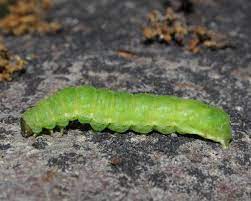
It is a small green larva with whitish dorsal lines. Other species have green or brown with red dots along their sides.
These crawling insects feed on the leaves of birches, hazels, brambles, oaks, hops, and common nettle plants.
Scientific Name |
Phlogophora meticulosa |
Host Plants |
Birches, hazel, bramble, oak, hop, and common nettle |
Identification Features |
Green body with a pale dotted line along its sides and narrow yellowish bands separating the segments. |
Dragon-Headed Caterpillar
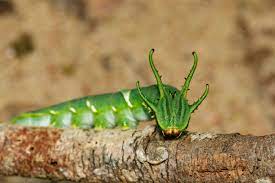
It is a long dark green slug-like caterpillar with a large head, small white spots, and whitish-yellow lateral stripes. The dragon-headed caterpillar is harmless to humans.
These crawling creatures feed on leguminous plants and are often seen in the spring to fall. The four pairs of prolegs with a white marking on each are distinctive features.
Scientific Name |
Polyura athamas |
Host Plants |
Ashes, maples, oaks, poplars, and hickories |
Identification Features |
Four long horns and conspicuous diagonal white stripes along the sides. |
Rosy Maple Caterpillar

It is a bright neon-green striped caterpillar with a brown head, black dots bands, and a pair of black antennae. The fat green caterpillar keeps changing its color in each instar.
Other distinctive features of rosy maple caterpillars are black spines, bulbous brown head, and black stripes running lengthwise.
Scientific Name |
Dryocampa rubicunda |
Host Plants |
|
Identification Features |
Bright green body with dark longitudinal stripes and two black horns. |
Cross-Striped Cabbage Worm
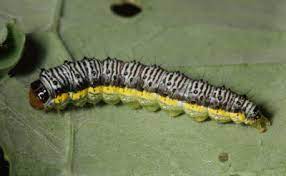
It is a green striped worm-like caterpillar with a yellow band, zebra-like markings, dark green dots, fine hairs, and a round brown head.
The green caterpillar darkens to deep blue or black as it matures. The fat green caterpillar turns into a spectacular tan-colored moth.
Scientific Name |
Evergestis rimosalis |
Host Plants |
Broccoli, Brussels, sprouts, cabbage, cauliflower, and collards |
Identification Features |
Distinctive yellow band along its sides, black dots on each segment, and black and white markings on greenish-white back. |
Tobacco Hornworm Caterpillar
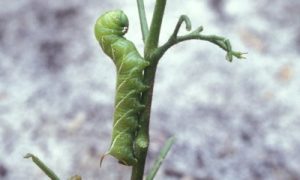
It is a large fat green caterpillar with diagonal white stripes and black dots along its sides. The rear horn can be green, orange or brown for easy identification.
Tobacco hornworms are harmless to humans though they can defoliate tomatoes, tobacco, and pepper plants. They can grow up to 7cm long with voracious appetite.
Scientific Name |
Manduca sexta |
Host Plants |
Tobacco, tomato, pepper, and eggplant |
Identification Features |
Green body with diagonal white and black stripes. The tiny black dots with white rings are other distinctive features. |
Spicebush Swallowtail Caterpillar
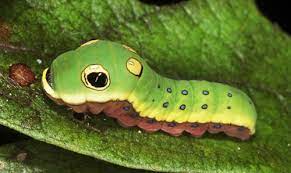
It is a pale-green caterpillar with a menacing appearance. The fat green caterpillar has bands of bluish-green dots around each segment.
The eye-like feature on the head has black and white markings to give the crawling insect a comical snake appearance.
These caterpillars can grow up 9.5cm long and keep changing the body color throughout their growth stages. They emit foul smell to ward off predators.
Scientific Name |
Papilio Troilus |
Host Plants |
Spicebush and sassafras |
Identification Features |
Pale green body with two false eyespots on the head and small blue or black dots in the transverse band. |
Fall Webworm
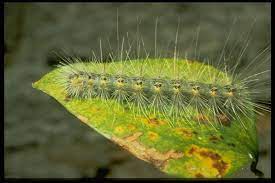
It is a yellowish-green worm-like caterpillar with tufts of long hair-like spines around its body. The furry caterpillar also has yellow spines sticking out all over its body.
These small fuzzy caterpillars come in a wide range of colors and make it challenging for identification. They can grow up to 2.5cm long despite their voracious appetite.
Scientific Name |
Hyphantria cunea |
Host Plants |
American elm, birch, hickory, and apple trees. |
Identification Features |
Yellowish-green worm-like insect with plumes of stinging hairs. |
Oak Slug Caterpillar
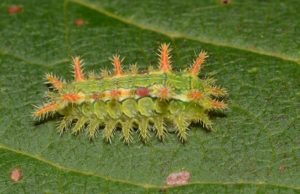
It is a vibrant green oval caterpillar with plumes of stinging spikes, and black and white ring-like markings. The slug-like caterpillar has orange or yellow fuzzy spikes on its back.
These crawling insects can grow up to 2cm long with conspicuous circular black patterns and white rings on their green body. They turn into brown hairy moths after pupation.
Scientific Name |
Euclea delphinii |
Host Plants |
Oaks, apples, maples, and plums. |
Identification Features |
Green elongated oval body with two orange stripes on its back. |
Crowned Slug Caterpillar
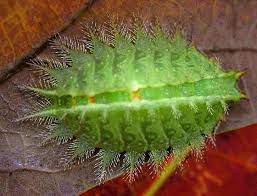
It is a strange-looking pale green caterpillar with a flattened oval body having stinging hairs sticking out from the sides. It causes skin irritation and nasty rashes.
These caterpillars can grow up to 1.5cm long and they resemble a fuzzy spherical leaves to hide from potential predators. Refrain from handling them without protective gloves.
Scientific Name |
Isa textula |
Host Plants |
Cherry, elm, hickory, maple, oak, poplar, and linden. |
Identification Features |
Oval pastel green caterpillar with plumes of stinging hairs on the sides. |
Cloudless Sulphur Butterfly

It is a green caterpillar with a yellow lateral stripe and a row of blue or black dots covering its body. The tiny black setae can cause skin irritation when handled.
The caterpillar bodies’ colors depend on the foliage they eat. The yellow species mean they feed on yellow petals and green counterparts on green leaves.
Scientific Name |
Phoebis sennae |
Host Plants |
Foliage of peas |
Identification Features |
Green body with a yellow lateral stripe on each side and rows of blue or black dots. |
Rough Prominent Moth Caterpillar
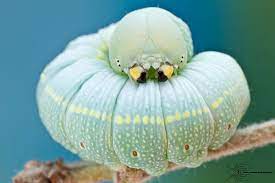
It is a pale-green to a turquoise plump caterpillar with a rounded head and tiny black eyespots. The yellowish speckles and pale-yellow stripes are the distinctive features.
The crawling insect is also called a white-dotted prominent or green oak caterpillar. These crawling creatures feed on the leaves of birch, alder, maple, willow, and cherry trees.
Scientific Name |
Nadata gibbosa |
Host Plants |
Oaks and other deciduous trees |
Identification Features |
Smooth fat green body with segments having yellow markings, a line of red dots near the abdomen, and a yellow mid-dorsal line. |
Io Moth Caterpillar
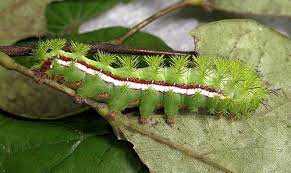
It is a fat lime-green caterpillar with red and white stripes running along its sides. The tufts of stinging green spines are the distinctive features.
The fuzzy green caterpillar grows up to 6cm long. The spines contain toxic substances that cause skin irritation when handled without wearing protective gloves.
Scientific Name |
Automeris io |
Host Plants |
Hackberries, willows, and blackberries. |
Identification Features |
Tufts of stinging green spines cover the fat lime-green body. |
Diamondback Moth Caterpillar
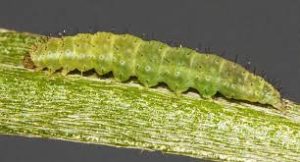
It is a small pale green caterpillar with short black spines and small white dots. The brown-to-black head and tapering end are the distinctive features.
This tiny green wriggling larva can grow up to 1cm long. The crawling insect keeps changing its color throughout its growth phases.
Scientific Name |
Plutella xylostella |
Host Plants |
Canola, mustard, broccoli, cabbages, cauliflower, and kale. |
Identification Features |
Short black spines sprouted from the whitish patches. |
Green Cloverworm
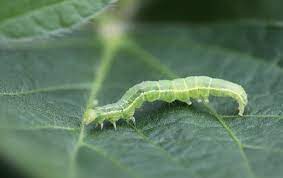
It is a green caterpillar with a yellowish-green head and thin yellow lines separating the segments. The pale greenish-white stripes along the sides are distinctive features.
Each abdomen has three pairs of prolegs and a pair on its rear. These crawling insects usually squirm when disturbed.
Scientific Name |
Hypena scabra |
Host Plants |
Clovers, beans, peas, and soybeans |
Identification Features |
Green caterpillar with segmented bodies separated by thin yellow lines. |
Hackberry Emperor Caterpillar
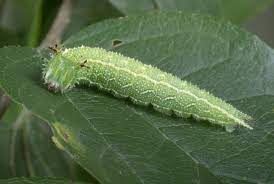
It is a light green caterpillar with two thin yellowish stripes running lengthwise along its body. The numerous tiny yellow dots covering the body are distinctive features.
Other distinctive features are a dark green head with two small horns and two sharp tails at its rear. The crawling insect can grow up to 4cm long.
These crawling insects are often seen in spring feeding on hackberry leaves and leaf buds. They turn into vibrant brown butterflies after pupation.
Scientific Name |
Asterocampa celtis |
Host Plants |
Hackberry tree leaves |
Identification Features |
Plump green caterpillar with a dark head covered in pale yellow bumps. |
Cecropia Moth Caterpillar

It is a strange-looking green caterpillar with yellowish-green colors that turn into bluish-green in the final growth stage.
The large segments have blue, green, or orange tubercles around the body. The colorful bumps sprout small black spikes that can cause skin irritation and nasty rashes.
Scientific Name |
Hyalophora cecropia |
Host Plants |
Birch, elm, box elder, maple, poplar, and willow |
Identification Features |
Yellowish-green caterpillar with orange tubercles around the body. |
European Puss Moth Caterpillar
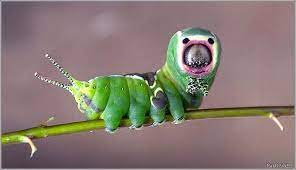
It is an unusual-looking moth caterpillar with a green body and long spiky tail for easy identification. The menacing caterpillar extends its red lashes when it is under threat.
The triangular head resembles a scary face to ward off other insects and potential predators. It belongs to the most venomous types of caterpillars in the world.
European puss moth caterpillars usually spit poisonous acid when they are annoyed or agitated. These crawling insects have close similarities with American puss caterpillars.
Scientific Name |
Cerura vinula |
Host Plants |
Aspen, willow, and poplar trees |
Identification Features |
Large plump green body with a long spiky tail and a triangular head. |
Rustic Sphinx Moth Caterpillar
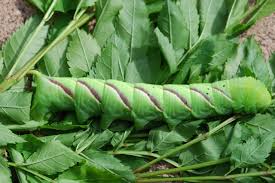
It is a green-horned caterpillar that hails from Florida, Texas, South Carolina, and Mississippi. The lime green body and diagonal white stripes are distinctive features.
The large spiky horn on its tail is an additional feature and does not sting. The horny tail can be yellow with red freckling for easy identification.
Scientific Name |
Manduca Rustica |
Host Plants |
American beautyberry, ash, basil, butterfly bush, crape myrtle, and lantana |
Identification Features |
Large bulky green caterpillar with diagonal white stripes and large horns. |
Hickory Horned Devil Moth Caterpillar
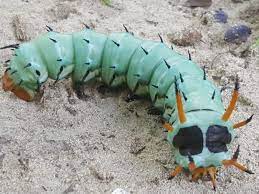
It is a large bluish-green caterpillar having long spiky red horns with black tips on its head to scare potential predators. Each segment has small black spikes for defense.
The evil-looking caterpillar is harmless since it does not bite or sting. It can grow up to 15cm long due to its voracious appetite.
Scientific Name |
Citheronia regalis |
Host Plants |
Walnut, hickory, pecan, sweetgum, and sumac |
Identification Features |
Bluish-green caterpillar with long spiky horns having black tips. |
Cabbage White Butterfly Caterpillar

It is a light green caterpillar that can be challenging to spot on cabbages, kales, bok choy, and broccoli plants. These moth caterpillars have a more voracious appetite.
These invasive green caterpillars have slender long bodies with noticeable green and yellow markings. They are also slightly fuzzy in appearance.
Scientific Name |
Pieris rapae |
Host Plants |
Bok choy, kales, cabbages, and broccoli |
Identification Features |
Juvenile has a black head that turns yellow and then green during each growth phase |
Luna Moth Caterpillar
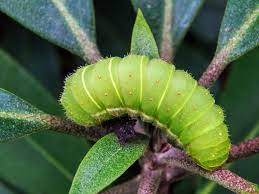
It is a spiky pale green moth caterpillar with segments having ridges. The ridges have red or orange dots with sprouting fine black spines.
The small fine black spines can cause skin irritation when handled. After pupation, these caterpillars turn into reddish-brown luna moths.
Scientific Name |
Actias luna |
Host Plants |
American sweet gum, sumac, and hickory trees. |
Identification Features |
Large green caterpillar with red or orange dots around the ridges on each segment. |
Copper Underwing Moth Caterpillar

It is a large fat green caterpillar that keeps changing its body color throughout its growth stages. Juvenile moth caterpillars have translucent pale green bodies.
A mature copper underwing moth caterpillar is darker with yellow stripes along its sides to indicate the time for the pupation phase.
The large protruding bump on its rear and lifting of the front part when resting are the distinctive features for easy recognition.
Scientific Name |
Amphipyra pyramidea |
Host Plants |
Ash trees, honeysuckle, rose, and lilac plants. |
Identification Features |
White-lined Sphinx Moth Caterpillar
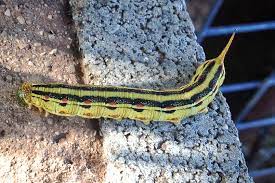
It is a lime-green caterpillar with noticeable black and yellow markings down its sides for easy identification. These crawling insects are harmless and safe to handle.
These horned caterpillars do not sting despite having a horn-like spike on the tail. The rows of black spots with yellow centers on the sides are distinctive features.
Scientific Name |
Hyles lineata |
Host Plants |
Apple trees, evening primrose, and fuchsia |
Identification Features |
Orange and black horns protruded from the back. |
Tiger Swallowtail Butterfly Caterpillar
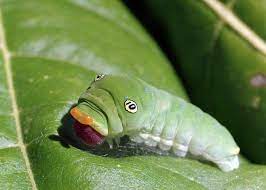
It is a strange-looking green caterpillar with distinctive eye-like markings. These crawling insects develop solid green bodies when they mature.
The tiger swallowtail caterpillars become dark brown when about to enter the pupation stage. The eyespots have yellow or pale green dots with black centers.
The white or yellowish bands behind the thorax are distinctive features. The eyespots are for defense mechanism against predators.
Scientific Name |
Papilio glaucus |
Host Plants |
Tulip tree and wild blackberry |
Identification Features |
Solid green body with eye-like markings on the head |
Emperor Moth Caterpillar
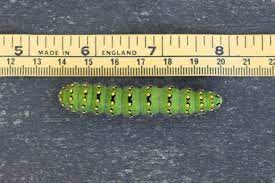
It is a large plump green caterpillar with rows of yellow dots around each segment for easy identification. It does not belong to a poisonous or stinging type of caterpillar.
The black rings wrapping around each segment feature orange and yellow spots. You can also notice tufts of tiny black hairs that can cause skin irritation.
Scientific Name |
Saturnia pavonia |
Host Plants |
Sallow, hazel, bramble, hawthorn, and heather |
Identification Features |
Large plump green caterpillar with rows of yellow dots wrapping each segment. |
Black Swallowtail Butterfly Caterpillar
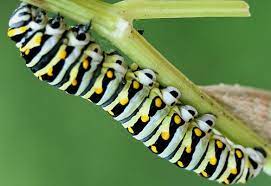
It is a lime-green caterpillar with spectacular black stripes and yellow markings around its body. Juvenile counterparts appear black that resemble bird poop on branches.
Each segment has black stripes with yellow markings for easy identification and classification. The black and yellow stripes are closer to the head.
Black swallowtail caterpillars release a foul smell as a defense mechanism. The orange-like tongue resembles a forked snake.
Scientific Name |
Papilio polyxenes |
Host Plants |
Carrots, dill, fennel, and parsley. |
Identification Features |
Lime-green body with striking black stripes and yellow markings. |
Genista Broom Moth Caterpillar
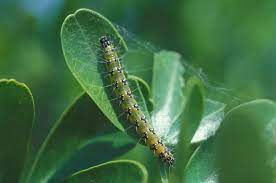
It is a small green caterpillar with black and white dots on its body. The crawling insect loves feeding on the foliage of honeysuckle, sweet peas, wild indigo, and acacia.
The black oval head with white dots is the distinctive feature for easy identification. It can grow up to 2.5cm long despite its voracious appetite.
The larvae have a number of white, black, and yellow patterns on each segment for easy recognition. The wispy spines make them be grouped into the furry type of caterpillars.
Scientific Name |
Uresiphita reversalis |
Host Plants |
Brooms, acacia, lupine, and wild indigo |
Identification Features |
Green caterpillar with black and white dots |
Winter Moth Caterpillar (Inchworm)
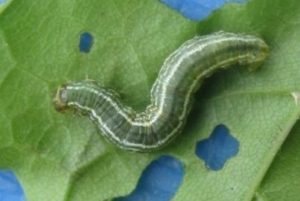
It is a tiny slender green caterpillar that grows up to an inch long. The pale white stripes running lengthwise and two pairs of legs on its rear are the distinctive features.
The larvae feed on the leaves of oak, maple, and apple trees. These invasive caterpillars are less destructive compared to other species.
Scientific Name |
Operophtera brumata |
Host Plants |
Oak, maple, and apple trees |
Identification Features |
Tiny slender green caterpillars with pale white stripes running lengthwise. |
Tomato Hornworm Caterpillar
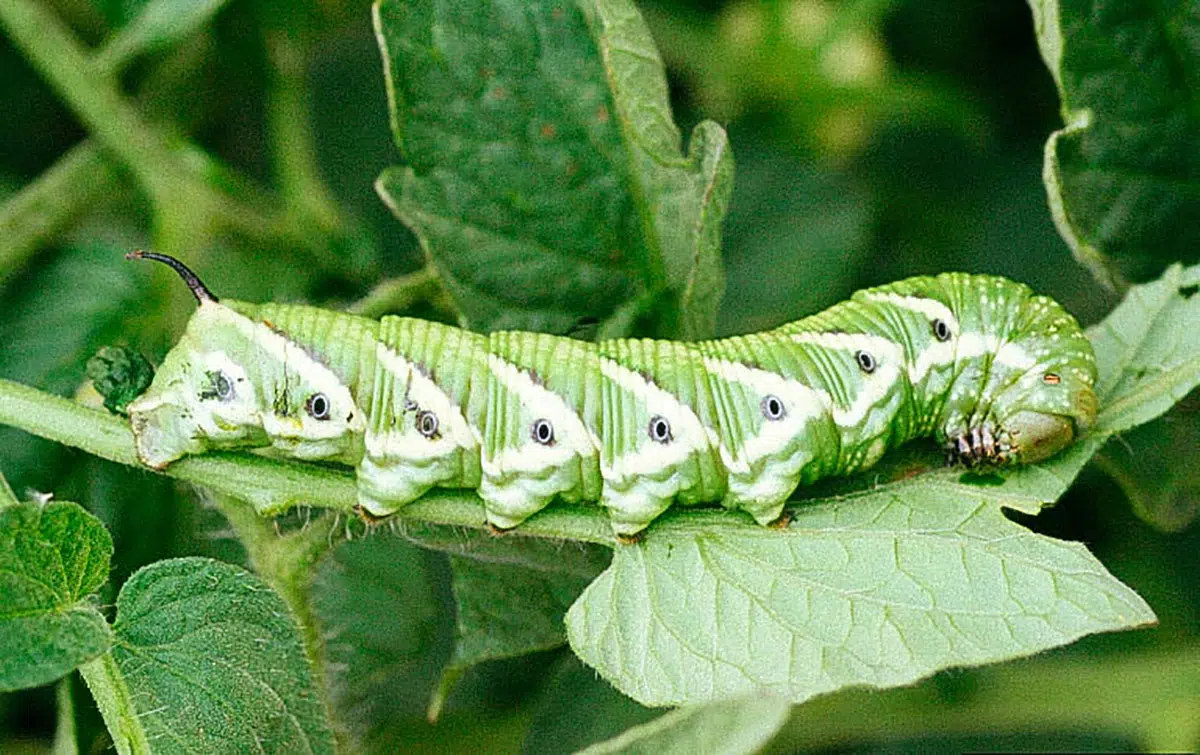
It is a green caterpillar with V-shaped white markings and a protruding tail that resembles a spike or horn. It is harmless despite the large scary head.
The caterpillar camouflage on the green leaves and vines of tomatoes. They are real garden pests that can destroy your crops.
Scientific Name |
Manduca quinquemaculata |
Host Plants |
Tomato plants |
Identification Features |
Distinctive V-shaped white stripes and black or dark spots along the sides. |
Related Articles:


